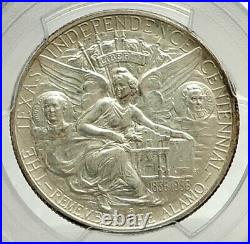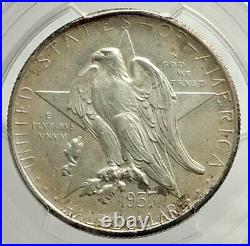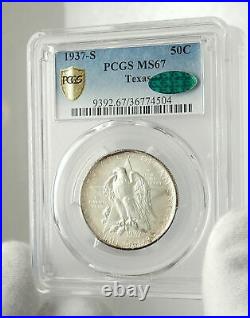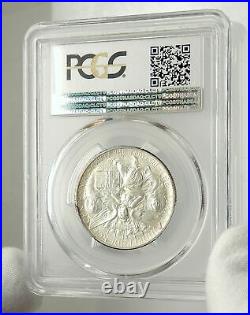





Item: i76467 Authentic Coin of. United States of America Texas Indepedence Centennial – Commemorative Issue 1937 S Silver Half Dollar 30.6mm (12.5 grams) 0.900 Silver 0.3617 oz. THE TEXAS INDEPENDENCE CENTENNIAL REMEMBER THE ALAMO 1836 1936, Winged Victory facing kneeling before Alamo Mission; and on each side, medallions with portraits of General Sam Houston and Stephen Austin, founders of the Republic and State of Texas. The Battle of the Alamo (February 23 – March 6, 1836) was a pivotal event in the Texas Revolution. Following a 13-day siege, Mexican troops under President General Antonio López de Santa Anna reclaimed the Alamo Mission near San Antonio de Béxar (modern-day San Antonio, Texas, United States), killing the Texian and immigrant occupiers. Santa Anna’s cruelty during the battle inspired many Texians, both legal Texas settlers and illegal immigrants from the United States, to join the Texian Army. Buoyed by a desire for revenge, the Texians defeated the Mexican Army at the Battle of San Jacinto, on April 21, 1836, ending the rebellion. Several months previously, Texians had driven all Mexican troops out of Mexican Texas. About 100 Texians were then garrisoned at the Alamo. The Texian force grew slightly with the arrival of reinforcements led by eventual Alamo co-commanders James Bowie and William B. On February 23, approximately 1,500 Mexicans marched into San Antonio de Béxar as the first step in a campaign to retake Texas. For the next 10 days, the two armies engaged in several skirmishes with minimal casualties. Aware that his garrison could not withstand an attack by such a large force, Travis wrote multiple letters pleading for more men and supplies from Texas and from the United States, but the Texians were reinforced by fewer than 100 men because the United States had a treaty with Mexico, and supplying men and weapons would have been an overt act of war. In the early morning hours of March 6, the Mexican Army advanced on the Alamo. After repelling two attacks, the Texians were unable to fend off a third attack. As Mexican soldiers scaled the walls, most of the Texian fighters withdrew into interior buildings. Occupiers unable to reach these points were slain by the Mexican cavalry as they attempted to escape. Between five and seven Texians may have surrendered; if so, they were quickly executed. Most eyewitness accounts reported between 182 and 257 Texians died, while most historians of the Alamo agree that around 600 Mexicans were killed or wounded. Several noncombatants were sent to Gonzales to spread word of the Texian defeat. The news sparked both a strong rush to join the Texian army and a panic, known as “The Runaway Scrape”, in which the Texian army, most settlers, and the new, self-proclaimed but officially unrecognized, Republic of Texas government fled eastward toward the United States ahead of the advancing Mexican Army. Within Mexico, the battle has often been overshadowed by events from the Mexican-American War of 1846-48. In 19th-century Texas, the Alamo complex gradually became known as a battle site rather than a former mission. The Alamo has been the subject of numerous non-fiction works beginning in 1843. Most Americans, however, are more familiar with the myths and legends spread by many of the movie and television adaptations, including the 1950s Disney mini-series Davy Crockett and John Wayne’s 1960 film The Alamo. Sam Houston (March 2, 1793 – July 26, 1863) was an American soldier and politician. An important leader of the Texas Revolution, Houston served as the 1st and 3rd president of the Republic of Texas, and was one of the first two individuals to represent Texas in the United States Senate. He also served as the 6th Governor of Tennessee and the 7th governor of Texas, the only American to be elected governor of two different states in the United States. Born in Rockbridge County, Virginia, Houston and his family migrated to Maryville, Tennessee when Houston was a teenager. Houston later ran away from home and spent time with the Cherokee, becoming known as “Raven”. He served under General Andrew Jackson in the War of 1812, and after the war he presided over the removal of many Cherokee from Tennessee. With the support of Jackson and others, Houston won election to the United States House of Representatives in 1823. He strongly supported Jackson’s presidential candidacies, and in 1827 Houston won election as the Governor of Tennessee. In 1829, after divorcing his first wife, Houston resigned from office, joined his Cherokee friends in Arkansas Territory. Houston settled in Texas in 1832. After the Battle of Gonzales, Houston helped organize Texas’s provisional government and was selected as the top-ranking official in the Texian Army. He led the Texian Army to victory at the Battle of San Jacinto, the decisive battle in Texas’s war for independence against Mexico. After the war, Houston won election in the 1836 Texas presidential election. He left office due to term limits in 1838, but won election to another term in the 1841 Texas presidential election. Houston played a key role in the annexation of Texas by the United States in 1845, and in 1846 he was elected to represent Texas in the United States Senate. He joined the Democratic Party and supported President James K. Polk’s prosecution of the Mexican-American War. Houston’s Senate record was marked by his unionism and opposition to extremists from both the North and South. He voted for the Compromise of 1850, which settled many of the territorial issues left over from the Mexican-American War and the annexation of Texas. He later voted against the Kansas-Nebraska Act because he believed it would lead to increased sectional tensions over slavery, and his opposition to that act led him to leave the Democratic Party. He was an unsuccessful candidate for the presidential nomination of the American Party in the 1856 presidential election and the Constitutional Union Party in the 1860 presidential election. In 1859, Houston won election as the Governor of Texas. In that role, he opposed secession and unsuccessfully sought to keep Texas out of the Confederate States of America. He was forced out of office in 1861 and died in 1863. Houston’s name has been honored in numerous ways, and he is the namesake of the city of Houston, the fourth most populous city in the United States. Stephen Fuller Austin (November 3, 1793 – December 27, 1836) was an American empresario. Known as the ” Father of Texas “, and the founder of Texas, he led the second, and ultimately, the successful colonization of the region by bringing 300 families from the United States to the region in 1825. Born in Virginia and raised in southeastern Missouri, Austin served in the Missouri territorial legislature before moving to Arkansas Territory and later Louisiana. His father, Moses Austin, received an empresario grant from Spain to settle Texas. After Moses Austin’s death in 1821, Stephen Austin won recognition of the empresario grant from the newly independent state of Mexico. Austin convinced numerous American settlers to move to Texas, and by 1825 Austin had brought the first 300 American families into the territory. Throughout the 1820s, Austin sought to maintain good relations with the Mexican government, and he helped suppress the Fredonian Rebellion. He also helped ensure the introduction of slavery into Texas despite the attempts of the Mexican government to ban the institution. He led the initial actions against the Karankawa people in this area. As Texas settlers became increasingly dissatisfied with the Mexican government, Austin advocated conciliation, but the dissent against Mexico escalated into the Texas Revolution. Austin led Texas forces at the successful Siege of Béxar before serving as a commissioner to the United States. Austin ran in the 1836 Texas presidential election but was defeated by Sam Houston. Houston appointed Austin as secretary of state for the new republic, and Austin held that position until his death in December 1836. Numerous places and institutions are named in his honor, including the capital of Texas, Austin in Travis County, Austin County, Austin Bayou, Stephen F. Austin State University in Nacogdoches, Austin College in Sherman, and a number of K-12 schools. World-renowned expert numismatist, enthusiast, author and dealer in authentic ancient Greek, ancient Roman, ancient Byzantine, world coins & more. Ilya Zlobin is an independent individual who has a passion for coin collecting, research and understanding the importance of the historical context and significance all coins and objects represent. Send me a message about this and I can update your invoice should you want this method. Getting your order to you, quickly and securely is a top priority and is taken seriously here. Great care is taken in packaging and mailing every item securely and quickly. What is a certificate of authenticity and what guarantees do you give that the item is authentic? You will be very happy with what you get with the COA; a professional presentation of the coin, with all of the relevant information and a picture of the coin you saw in the listing. Additionally, the coin is inside it’s own protective coin flip (holder), with a 2×2 inch description of the coin matching the individual number on the COA. Whether your goal is to collect or give the item as a gift, coins presented like this could be more prized and valued higher than items that were not given such care and attention to. When should I leave feedback? Please don’t leave any negative feedbacks, as it happens sometimes that people rush to leave feedback before letting sufficient time for their order to arrive. The matter of fact is that any issues can be resolved, as reputation is most important to me. My goal is to provide superior products and quality of service. How and where do I learn more about collecting ancient coins? Visit the Guide on How to Use My Store. For on an overview about using my store, with additional information and links to all other parts of my store which may include educational information on topics you are looking for. The item “1937 S TEXAS Independence Commemorative Silver Half Dollar Coin PCGS MS i76467″ is in sale since Saturday, March 9, 2019. This item is in the category “Coins & Paper Money\Coins\ US\Commemorative\Silver (1892-1954)”. The seller is “highrating_lowprice” and is located in Rego Park, New York. This item can be shipped worldwide.
- Country/Region of Manufacture: United States
- Certification: NGC
- Year: 1937
- Composition: Silver
- Grade: MS 67
- Certification Number: 9392.67/36774504
- Mint Location: San Francisco
- Circulated/Uncirculated: Uncirculated
- Denomination: Denomination_in_description

